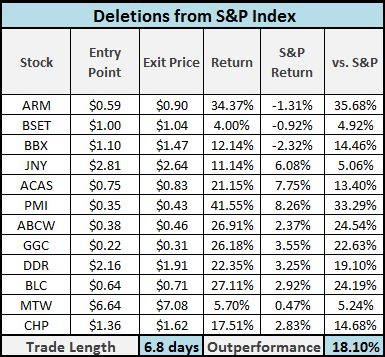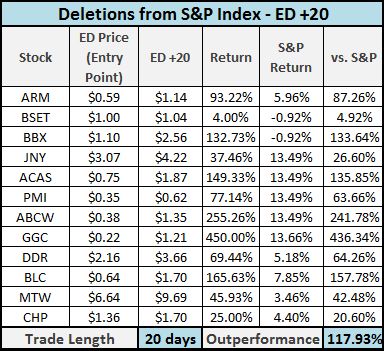This is part two of my series on abnormal stock market anomalies. I originally wrote a post about the S&P 500 index effect.
The second part of the series will focus on deletions.
S&P Deletions
Each time a stock is added to an S&P index, a corresponding deletion occurs to keep constant the number of companies with the index.
S&P has the option of moving stocks down to a lower index such as the S&P MidCap 400 or S&P SmallCap 600, or deleting them from all indices.
Firms are deleted for a number of reasons: declining market cap, a merger with another company, or moving headquarters to a foreign country.
The key theory behind this strategy:
Index funds and other institutional investors must indiscriminately sell their holdings in stocks deleted from the index, without regard to current financials, future outlook, or intrinsic value.
Price Movements for Deletions
For deletions, the effect is the opposite of stocks added to the index. The price drops sharply after the Announcement Date (AD) until the Effective Date (ED) as institutional investors dump the stock.
Trading Strategy
In the book, the primary strategy for deletions is to purchase the stock after the effective date, with the goal of capturing a rebound in stock price caused by the indiscriminate selling during the announcement period.
For these results, stocks were purchased on the close of the effective date. Price targets were set at 1.5x the abnormal drop in price during the announcement period, with positions closed after 20 business days if the target exit price is unmet.
Recent Results
There were 12 events that met the criteria for this trading strategy. Only 1 stock, BSET, failed to reach its target price within the 20 day window.
Average outperformance was 18.10%, with stocks reaching their target exit price after only 6.8 days on average.
Results through ED +20
To further test the strategy, stocks were tracked for the full twenty day period after the effective date, with even better results:
Conclusions
Logically, some stocks removed from the index are on the verge of bankruptcy, having suffered significant loss in market cap over the previous weeks or months.
In this limited sample, this was not the case, as all stocks recovered their initial drop in price, before continuing to appreciate rapidly.
Recent results seem to show a large, abnormal price increase after a stock is deleted from the S&P indices.
Discussion
Why such a large outperformance? Could these stocks be candidates for value investors, a la the mindset around stock spinoffs in Joel Greenblatt’s book?
What are your theories?
Disclosure
No position in any of these stock at the time of this writing.



Very interesting articles on S&P indexing. I have heard that the effects with the Russell are more striking given that these stocks are more illiquid. Have you done any work on it?
Plan,
I did a bit of research on the Russell effect, and actually found that the outperformance seemed to be much lower.
Since additions & deletions to the Russell Index are much easier to determine (based on a hard market cap ranking on a given date, and only once a year), there seems to be some bujilt-in arbitrage leading up to the event.
I’m planning on writing a follow-up blog post and will reference your comment in more detail.
I have a couple of observations.
In calculating the returns did you factor in bid/ask spreads? Given the low prices on some of the stocks that could have a significant impact.
In calculating the average return from the strategy did you equally weight each security? Since some of the time periods overlapI think you need to equally weight each date, not each security. For example, you could not have invested as much in JNY, ACAS, PMI, and ABCW as you could have in some of the other stocks since those four appear to have the same announcement date.
I enjoy your blog. Keep up the good work.
Chuck,
Thanks for the kind words.
I did not take into account bid-ask spreads in these numbers. Although this will certainly affect the results to some degree, even with the most illiquid stocks, there still seems to be a substantial record of outperformance. Another consideration: studies have shown that volume increases significantly around the announcement and effective dates, and I’m assuming the bid-ask spread shrinks during this time period as well.
In any case, is there a resource for historical bid/ask spreads for given stocks on a given day?
For this analysis, I equally weighted the portfolio. I understand your point about capital deployment considerations, but situations will change from investor to investor. Keeping a percentage of your portfolio in cash (ready to deploy when opportunities are presented), seems to be the hallmark of many great value investors – I think this mindset could apply in these situations as well.
[…] Part 2 – S&P Deletions: Unwanted Stocks Lead to Market Beating Returns […]
[…] second part of the series focused on S&P deletions. The stocks in my sample from the past two years generated outstanding returns, substantially […]